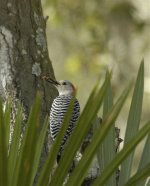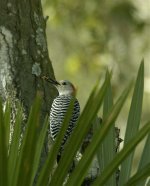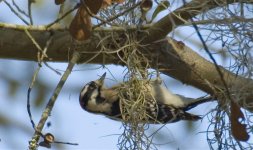I took this today with my D70 and my Sigma 170-300mm. I just can't seem to get the kind of sharpness that I would like. This was taken handheld using aperture priority at f8. I know I should have set up a tripod but I had no time to go back and get it. Any suggestions would be great.
-
Welcome to BirdForum, the internet's largest birding community with thousands of members from all over the world. The forums are dedicated to wild birds, birding, binoculars and equipment and all that goes with it.
Please register for an account to take part in the discussions in the forum, post your pictures in the gallery and more.
You are using an out of date browser. It may not display this or other websites correctly.
You should upgrade or use an alternative browser.
You should upgrade or use an alternative browser.
Just not sharp! Please Help! (1 Viewer)
- Thread starter Big-V316
- Start date
More options
Who Replied?tracker
Tom
Hello Big-V,
Thats a great looking bird; well done on getting the shot :t:
My suggestion here, would be to work at finding the distance your particular lens works best. Sometimes its too easy to think we can stretch its capabilities to pull in a distant bird; only to our disatisfaction.
You may even have to develop your fieldcraft and get closer to your subjects somehow.
Practice on feeder shots or at local wildlife centres; this may help you work out your lens' best range.
Regards,
Thats a great looking bird; well done on getting the shot :t:
My suggestion here, would be to work at finding the distance your particular lens works best. Sometimes its too easy to think we can stretch its capabilities to pull in a distant bird; only to our disatisfaction.
You may even have to develop your fieldcraft and get closer to your subjects somehow.
Practice on feeder shots or at local wildlife centres; this may help you work out your lens' best range.
Regards,
psilo
Well-known member
Tom is right. I think from the blurred plant n the foreground you have definatly found your target and have got it as sharp as you probably could get given your situation. Maybe if you opened it up a bit more you might have got a faster shutter speed but dont think it would have made any real difference here. If you arent using it already also make sure you select one shot on your focus mode as this locks on and is the best focus to use on birds that are sat posing like this one. Nice shot.
Spot Focus
Well-known member
Hi although the camera setting maybe correctI took this today with my D70 and my Sigma 170-300mm. I just can't seem to get the kind of sharpness that I would like. This was taken handheld using aperture priority at f8. I know I should have set up a tripod but I had no time to go back and get it. Any suggestions would be great.
Thanks for all the input. One question I do have is what Camera settings should I use? As of right now I have been using aperture priority but in this mode if my subject is in shade I see my shutter speeds drop to under 1/100 or 1/60 causing even more shake even on a tripod. Should I try shutter priority and loose control of DOF or should I try manual and have more things to try to fuss with while I am trying to focus on some jittery bird. I have tried all of these and am still very confused as to which would be the best way to go. Thanks again.
a.dancy
Registered User
Thanks for all the input. One question I do have is what Camera settings should I use? As of right now I have been using aperture priority but in this mode if my subject is in shade I see my shutter speeds drop to under 1/100 or 1/60 causing even more shake even on a tripod. Should I try shutter priority and loose control of DOF or should I try manual and have more things to try to fuss with while I am trying to focus on some jittery bird. I have tried all of these and am still very confused as to which would be the best way to go. Thanks again.
It does not matter whether you go manual or whatever. You cannot give yourself more light if it is not there. All you can do is keep your aperture wide open open to give more light and therefore obtain a slightly faster shutter speed to freeze the bird's movement. It is often advised that shooting at f8 will provide more sharpness than say shooting at f5.6 and this generally is true. However, with the lenses I have tested the difference in sharpness is not so vast and any decrease in sharpness shooting at f5.6 is more than made up for by the faster shutter speed freezing the bird and reducing lens shake. Having said that I have not used your lens before so you will need to do a bit of a test for yourself to see how much softer an image may become when shooting at f5.6. You are not going to have a depth of field problem shooting at f5.6 with a woodpecker which is side on or back on unless you get very close and it is head on.
Getting super sharp shots is nearly always desireable but it seems to be a hang-up photographers have. Even very poor equipment can still pruduce acceptably sharp shots that would make nice prints at up to about A4 size provided the shot has been taken well. IMHO
One of the things I like most about the Nikon D3 is the ability to use much higher iso and so my shutter speeds can be higher. With the 1.4x on my 300/f4 I get good results at 1/2000 at f8 so I adjust the iso to give me these speeds (hand held ) . Of course on a tripod you could get away with much less if the bird is not moving too fast. Without the 1.4x I like at least 1/1000 at f8. I'm not too worried about noise anymore with the D3 but I always prefer noise over softness any day.
I was photographing a female Daurian Redstart yesterday at f6.3 ( about 4 meters ) and when focused on the wing with the bird's head angled away from me the head was soft. This is why I like f8.
Neil
I was photographing a female Daurian Redstart yesterday at f6.3 ( about 4 meters ) and when focused on the wing with the bird's head angled away from me the head was soft. This is why I like f8.
Neil
IanF
Moderator
Looks to me like camera shake as well.
I'd stick with using AV mode but sacrifice shutter depth of field for shutter speed by leaving the lens wide open - as a sharp photo is better. With a 300mm lens you should be looking for at least 1/300. I can get away with hand holding a 400mm lens at 1/400 sec but it's preferable to have something to lean against or use a monopod.
If there's sufficient light then you can increase aperture. In effect by using higher ISO you increasing the available light - but at the cost of noise/graininess. Doubling the ISO (e.g. ISO200 to ISO400) doubles the shutter speed (e.g. 1/250 becomes 1/500) or gains you an extra full f-stop. As to how much noise there is depends on the camera model. On my Canon 40D I use ISO400 as standard but can go up to ISO1000 for usable results if needed.
In these circumstances I'd be using the lens wide open and experimenting with higher ISO plus using at least a monopod. Tripods can be cumbersome to cart a round but a monopod is quite compact - I often have mine with me - just make sure it's a sturdy one. Some can be quite flexible when you lean on them.
I'd stick with using AV mode but sacrifice shutter depth of field for shutter speed by leaving the lens wide open - as a sharp photo is better. With a 300mm lens you should be looking for at least 1/300. I can get away with hand holding a 400mm lens at 1/400 sec but it's preferable to have something to lean against or use a monopod.
If there's sufficient light then you can increase aperture. In effect by using higher ISO you increasing the available light - but at the cost of noise/graininess. Doubling the ISO (e.g. ISO200 to ISO400) doubles the shutter speed (e.g. 1/250 becomes 1/500) or gains you an extra full f-stop. As to how much noise there is depends on the camera model. On my Canon 40D I use ISO400 as standard but can go up to ISO1000 for usable results if needed.
In these circumstances I'd be using the lens wide open and experimenting with higher ISO plus using at least a monopod. Tripods can be cumbersome to cart a round but a monopod is quite compact - I often have mine with me - just make sure it's a sturdy one. Some can be quite flexible when you lean on them.

A very nice shot.
I would however process it a little to get the most from it (at risk of stating the obvious). You can't always have the perfect setup of a tripod etc if you want to catch a moment, so I think you did fine.
I would be happy if I got any pictures like this myself.
Malvin.
I would however process it a little to get the most from it (at risk of stating the obvious). You can't always have the perfect setup of a tripod etc if you want to catch a moment, so I think you did fine.
I would be happy if I got any pictures like this myself.
Malvin.
Attachments
I did some research on long lens technique and tried again this morning. Both my little friend and I were in the shade of some oak trees and I was standing about 25 to 30 feet away. This is a 75% crop of a picture that was shot at ISO 400 my shutter speed was also 400 and I was zoomed out to 500mm. This was taken using matrix metering. I was using my Nikon d70 and Sigma 170-500mm. Please let me know if I am moving in the right direction. Thanks.
Attachments
Whilst camera shake looks like its the main issue the 170-500mm Sigma zoom isn't renowned for being razor sharp at the 500mm end. If you could get slightly closer and pull the zoom back to 450mm I think you'd notice quite an improvement. Perhaps shooting at 1/800 with the D70 set on autoiso would have helped to eliminate motion blur
The RB Woodpecker photo shows quite a bit of c.a/colour fringing especially on the surrounding twigs which is surprising for an apo lens. If this is removed in photoshop or similar the overall photograph will look significantly better. Although I don't want to be too critical personally I think the photo is underexposed. If it was half a stop brighter again it'd help to improve the overall sharpness.
The RB Woodpecker photo shows quite a bit of c.a/colour fringing especially on the surrounding twigs which is surprising for an apo lens. If this is removed in photoshop or similar the overall photograph will look significantly better. Although I don't want to be too critical personally I think the photo is underexposed. If it was half a stop brighter again it'd help to improve the overall sharpness.
Users who are viewing this thread
Total: 2 (members: 0, guests: 2)






